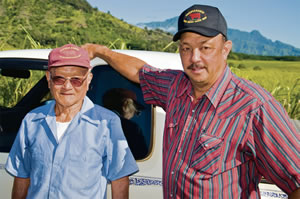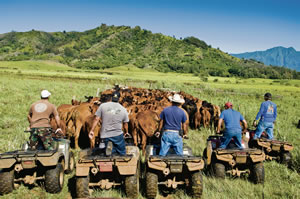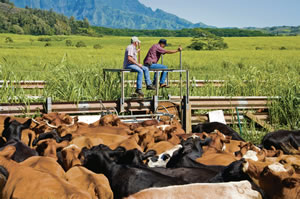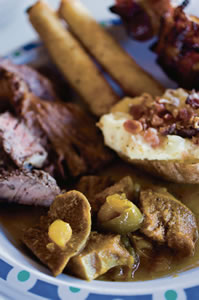Why Grass Is Best In Beef

Kenichi and Duane Shimogawa. Daniel Lane photos
Duane Shimogawa Sr. raises 100 percent all-natural, grass-fed cows that graze on 1,600 acres of pristine Kaua’i pasture. A’akukui Ranch’s beef is hormone- and antibiotic-free.
GRASS-FED BEEF
“(Our beef) is a sustainable product, and everything stays here in the local economy,” says Shimogawa.
Buying local beef ensures that we will have a steady supply if a natural disaster happens, or if shipments don’t arrive.
Season: Because of the growing conditions On Kaua’i, grass grows all year so Shimogawa’s beef is available year-round.
What to look for: The fat from grass-finished beef may have a yellowish appearance from the elevated carotenoid content, which makes it high in antioxidants. Grass-fed beef has a distinct grass flavor.

Shimogawa rounds up his cattle with ‘Japanese quarterhorses
Storage: Store in the refrigerator for up to three days, or freeze for one month.
Tip: In nature, cattle eat grass, so this type of beef tastes exactly how beef is supposed to taste. Grain is used to fatten up cows before slaughter, because this is the more common practice, people have grown accustomed to the way grain-fed beef tastes. Grass fed beef is prized for its healthy properties including less saturated fat then grain-fed beef.
Preparation: Grass-fed beef has less fat and this should be considered when cooking. Oil a hot skillet and sear tenderloin steaks for about 5 minutes on each side, for medium rare; 6 minutes a side for top loin steaks.
Health benefits: Grassfed beef is high in Omega 3 fatty acids, antioxidants and vitamins A and E. It doesn’t elevate cholesterol as much as grain-fed beef. Research spanning three decades suggests that grassbased diets can significantly improve the fatty acid composition and antioxidant content of grass-fed beef.
A’akukui Ranch beef can be found at:

His Kaua‘i-grown beef is ‘sustainable,’ says Shimogawa: ‘Everything stays here’. Daniel Lane photos
Grocery: Ishihara Market, Sueoka Store, Kukuiula Market.
Restaurants: Oasis on the Beach and 22 North. “We work very closely with 22 North and their farmto-table concept,” says Shimogawa. “They take the whole animal and butcher it themselves. It’s a real neat operation.”
Call 245-2450 for details.
TUTU’S TONGUE RECIPE
Duane invited my hus-band Dan and I to his ranch for a family barbecue. His father Kenichi and mother Mary were kind enough to share their recipe for beef tongue. If cooked properly, tongue has a silky texture and mild taste. Tongue is high in vitamin B12 and iron.

Mary’s zesty tongue
* 1 A’akukui Ranch tongue
* 1/4 cup salt
* 1 tablespoon pepper
* 1 tablespoon garlic salt
* 4 or 5 Hawaiian chili peppers
* 1 14-ounce can tomato sauce
* 1 bell pepper, diced
* 1 onion, diced
* 1 potato, peeled and cubed
* 2 garlic cloves, minced
Place tongue, salt, pepper, garlic salt and chili peppers in a large pot, cover with water and bring to a boil. Reduce heat, cover and simmer for 2 1/2 hours. Let cool. Peel skin off tongue. Kenichi likes to slice it thinly and add it back to the cooking broth to warm before eating.
Mary stir-fries bell pepper, onion, and garlic, and then adds 2 cups of thinly sliced tongue, potato, and 3 cups of water. She lets this simmer for 30 minutes before serving.



